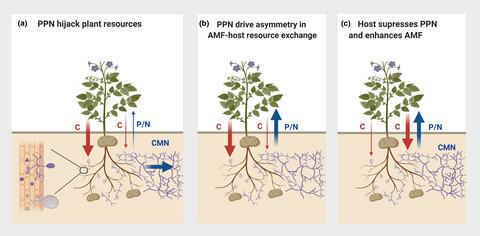当前位置:
X-MOL 学术
›
Ecol. Evol.
›
论文详情
Our official English website, www.x-mol.net, welcomes your
feedback! (Note: you will need to create a separate account there.)
The influence of competing root symbionts on below‐ground plant resource allocation
Ecology and Evolution ( IF 2.3 ) Pub Date : 2021-03-02 , DOI: 10.1002/ece3.7292 Christopher A Bell 1 , Emily Magkourilou 1 , Peter E Urwin 1 , Katie J Field 2
中文翻译:

竞争性根共生体对地下植物资源分配的影响
更新日期:2021-04-04
Ecology and Evolution ( IF 2.3 ) Pub Date : 2021-03-02 , DOI: 10.1002/ece3.7292 Christopher A Bell 1 , Emily Magkourilou 1 , Peter E Urwin 1 , Katie J Field 2
Affiliation

|
- Plants typically interact with multiple above‐ and below‐ground organisms simultaneously, with their symbiotic relationships spanning a continuum ranging from mutualism, such as with arbuscular mycorrhizal fungi (AMF), to parasitism, including symbioses with plant‐parasitic nematodes (PPN).
- Although research is revealing the patterns of plant resource allocation to mutualistic AMF partners under different host and environmental constraints, the root ecosystem, with multiple competing symbionts, is often ignored. Such competition is likely to heavily influence resource allocation to symbionts.
- Here, we outline and discuss the competition between AMF and PPN for the finite supply of host plant resources, highlighting the need for a more holistic understanding of the influence of below‐ground interactions on plant resource allocation. Based on recent developments in our understanding of other symbiotic systems such as legume–rhizobia and AMF‐aphid‐plant, we propose hypotheses for the distribution of plant resources between contrasting below‐ground symbionts and how such competition may affect the host.
- We identify relevant knowledge gaps at the physiological and molecular scales which, if resolved, will improve our understanding of the true ecological significance and potential future exploitation of AMF‐PPN‐plant interactions in order to optimize plant growth. To resolve these outstanding knowledge gaps, we propose the application of well‐established methods in isotope tracing and nutrient budgeting to monitor the movement of nutrients between symbionts. By combining these approaches with novel time of arrival experiments and experimental systems involving multiple plant hosts interlinked by common mycelial networks, it may be possible to reveal the impact of multiple, simultaneous colonizations by competing symbionts on carbon and nutrient flows across ecologically important scales.
中文翻译:

竞争性根共生体对地下植物资源分配的影响
植物通常同时与多种地上和地下生物相互作用,其共生关系涵盖从共生(例如与丛枝菌根真菌(AMF))到寄生(包括与植物寄生线虫(PPN)的共生)的连续体。
尽管研究揭示了在不同宿主和环境限制下植物资源分配给互利 AMF 伙伴的模式,但具有多个竞争共生体的根生态系统经常被忽视。这种竞争可能会严重影响共生体的资源分配。
在这里,我们概述并讨论了 AMF 和 PPN 之间对宿主植物资源有限供应的竞争,强调需要更全面地了解地下相互作用对植物资源分配的影响。基于我们对豆科植物-根瘤菌和 AMF-蚜虫-植物等其他共生系统的理解的最新进展,我们提出了关于对比地下共生体之间植物资源分配以及这种竞争如何影响宿主的假设。
我们在生理和分子尺度上确定了相关的知识差距,如果这些知识差距得到解决,将提高我们对真正的生态意义的理解,以及未来潜在的 AMF-PPN-植物相互作用的开发,以优化植物生长。为了解决这些突出的知识差距,我们建议在同位素示踪和营养预算中应用成熟的方法来监测共生体之间营养物的移动。通过将这些方法与新颖的到达时间实验和涉及通过常见菌丝体网络互连的多个植物宿主的实验系统相结合,有可能揭示竞争共生体对碳和养分流在生态重要尺度上的多个同时定植的影响。











































 京公网安备 11010802027423号
京公网安备 11010802027423号